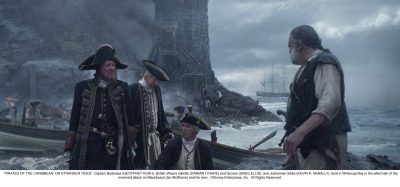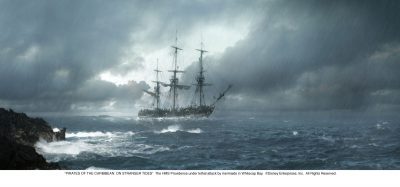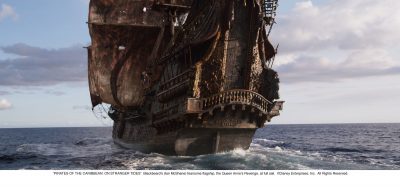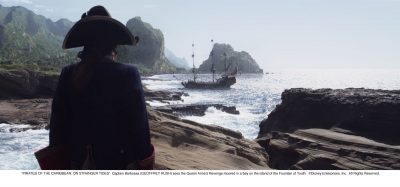MPC contributed around 300 shots to Rob Marshall’s Pirates of the Carribbean: On Stranger Tides, made up of CG ships, waterfalls and environment work. We talk to MPC’s visual effects supervisor Gary Brozenich about just some of the studio’s shots and working for the first time in native stereo.
fxg: Can you give me an overview of MPC’s effects work for the film?

Brozenich: We worked on four or five sequences. We had to do a number of environment extensions, some cliffs and waterfalls. We did full CG shots of Jack Sparrow jumping off a cliff into a water pool. We then did another sequence where sailors on the ship, the Providence, get attacked by mermaids and they rip the ship apart and sink it. We also did a nighttime sequence on the Queen Anne’s Revenge, where Blackbeard manages to make the ship attack the sailors with ropes coming to life after they had tried to mutiny. Finally, we did a number of peg leg and miscellaneous shots, and the whips the mermaids throw in the end sequence. The work we did, with the exception of the ships being sunk very quickly, were primarily invisible effects and very naturalistic.
fxg: What was involved in creating the Jack Sparrow jump from the cliff?
Brozenich: We went to a location in Hawaii and we did actually shoot material of a stuntman jumping off the waterfall. Then it was a cut to his landing, so we actually did shoot in an amazingly beautiful location – the problem was the waterfall was probably only about 30 feet high. This wasn’t a planned shot for us to do, but we had already made a digi-double of Jack for other sequences. When they got back and started cutting, it became clear they weren’t getting the impact of his actual dropping or descending 250 feet.
So we started off with this cut of two different shots, and then [overall visual effects supervisor] Charlie Gibson came to us and asked what could we do to join those two takes. We would have an A plate of him jumping, B was our CG work in the middle and C was him landing. The plates were shot at different focal lengths and without these angles in mind, so what eventually evolved was us re-creating portions of the A plate with projection and additional matte painting. It was probably about 90 per cent CG in the end. We kept the splash and some of the foreground water from the C plate, but that was about it. The digi-double work that we did was something that evolved from a cut requirement rather than having shot with that in mind.
fxg: There’s a number of views of ships and the pirates are on the Fountain of Youth island – how did you approach those?

Brozenich: When they shot that, we had crystal clear blue sky and straight sunlit day. The director and Charlie wanted to play the scene as being overcast and in the middle of the storm and raining. Our plates were blue sky, a lot of sunlight on the actors and rain from a rain machine, so the challenge for us on that was try and work with the existing natural light in the plate, but to make it into a more believable overcast day.
We would rotoscope the very foreground and the mid-ground rock, which played on the left hand side most of the time, and ended up doing a more or less full replacement of the sky, huge parts of the water surface. We also added a lighthouse in there which didn’t exist for real. So again the backgrounds, through attrition, ended up being largely CG with digital boats and an ocean, while the plates in the foreground had a minimal amount of manipulation. The lighting on the actors was fairly sympathetic to having a patchy sunlit sky. Charlie and I agreed from the start to do as little manipulation to the principal actors as possible.
fxg: How did you approach the ropes that attack the sailors on Blackbeard’s ship?
Brozenich: On a shooting level, the plates were filmed with stunt guys on wires. We had to wait until we got the cut to figure out how it would play. We weren’t sure if they were going to go with something a little more playful – having a life of their own or if they were just real ropes being controlled by one mind and driven that way to attack the men. That ended up being the general feel we went for.
On a technical level, they were animated as keyframed ropes. They had a spline control and the animators animated it directly – purely an FK process. Some of the ropes had a dynamic groom with little hairs and fibers that stuck up off them.
fxg: Were you augmenting any of the sails of the ships or water motion?

Brozenich: Yes. Firstly, for the Queen Anne’s Revenge, the ship that Blackbeard sailed, that was a metal purpose-built vessel that had a modern contemporary full, with a diesel powered engine. It didn’t have any sails above the first level – so everything above was created by us. One of the things we struggled with was when they shot out at sea, the boat was driven by an engine and not by the wind, was that even the sails that did exist didn’t normally obey the behavior that everyone wanted. So in post we ended up taking a lot of the sails that had been inverted, and rotoscoping people off the deck and replacing the ground level sails as well.
On the Providence, which eventually gets torn down, that was a full functioning sailing vessel. It was pretty amazing because when we were on it filming that had a proper sailing crew who were volunteers and shot it with us in the Port of Los Angeles. That actually did have a full set of sails on it, but we had to do a few clean-ups on the live action ship. Then there was also a full CG version when it is torn down with CG sailors made using our ALICE crowd system.
fxg: What were some of the stereo challenges you had to deal with for the film?
Brozenich: It was the first film we’ve ever worked on that was shot native stereo. This meant at the very beginning we didn’t have a pipeline in place to deal with stereo in that way. We had done 3D shots on other films of course, but what it was there involved dimensionalizing through rendering two eyes in CG. So really from the start we had to make our own pipeline.

Myself and Marian Mavrovic, the compositing supervisor, and Doug Larmour, the head of 2D, sat down and we wanted to take the best of what we had seen and read about for stereo. We settled on a pipeline that at the front end was driven by Ocular from The Foundry. We set up a standard process where plates would come in and we would put them through a ‘triage’ stage. When they shot this film, it was shot parallel without convergence Z, and on a beam splitter rig. This means they shoot the left eye as the dominant eye straight and through a mirror, and then the right eye, the right hand camera, is actually mounted perpendicular to it and shoots down onto the mirror. So it shoots the reflection in the mirror.
The result of that is that you do end up with certain anomalies, vertical and horizontal shift and a little bit of skewing. What you need to do is vertically and color align the two eyes to themselves to have as best a matching set as you can get. It makes a big difference for viewing it in stereo. If you view something that’s not been perfectly vertically aligned or color aligned, you get almost a shimmer between the two eyes. So we would prep the plates first and only then would they go into the production pipeline. In the end, it was a really enjoyable experience working in stereo and we got the benefit of having that added dimension.
Images © 2011 Disney Enterprises, Inc. All Rights Reserved.
